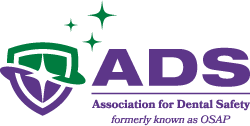|
Home > Resources > Best Practices > Best Practices for Occupational Exposure to Blood Best Practices for Occupational Exposure to Blood
Why it MattersHealth care personnel are at risk for occupational exposure to bloodborne pathogens that can cause diseases. These include, but are not limited to, hepatitis B virus (HBV), hepatitis C virus (HCV), and HIV. Even when blood is not visible, it can still be present in limited quantities in saliva. Both blood and saliva are considered potentially infectious materials by the Occupational Safety and Health Administration (OSHA). BackgroundOccupational exposures can occur when infected blood from a patient comes in contact with the eyes, nose, mouth, or broken skin of a provider. They can also occur through needlesticks or cuts from other sharp instruments contaminated with infected blood (including blood-contaminated saliva). Risk of exposures can be reduced by following a hierarchy of controls including elimination, substitution, administrative controls, engineering controls, and personal protective equipment (PPE). For example, in dental settings, splashes to the eyes, nose, mouth, and skin can be reduced by properly using high volume evacuation systems and PPE such as gloves, eye and face protection, and gowns. Needlesticks and other cuts can be prevented by using engineering controls (for example, disposing of used needles in appropriate sharps disposal containers and using medical devices with safety features designed to prevent injuries) and safer techniques (for example, not recapping needles by hand). CDC's National Institute for Occupational Safety and Health (NIOSH) developed the Hierarchy of Controls, which defines various levels of controls that can lower worker exposures and reduce risk of illness or injury. Additionally, NIOSH created a bloodborne pathogens page that provides information on handling needlestick or sharps injuries and exposure to patient blood or body fluids in a health care setting. RecommendationsTo prevent occupational exposure to blood, CDC recommends to:
More information on preventing occupational exposure to blood can be found on pages 3, 12–14, 40, and 62 of CDC’s Guidelines for Infection Control in Dental Health-Care Settings—2003. What should you do if you have had an occupational exposure?If you experience a needlestick, cut yourself with a sharp instrument, or are exposed to the blood or another body fluid of a patient, immediately follow these steps:
Health care professionals caring for exposed health care workers can call the National Clinicians' Post-Exposure Prophylaxis Hotline (PEPline) for advice on managing occupational exposures to HIV and hepatitis B and C viruses. PEPline is available 24 hours a day, 7 days a week, at 1-888-448-4911. Read NextBest Practices for Oral Surgical Procedures > Source: CDC Best Practices for Occupational Exposure to Blood |

